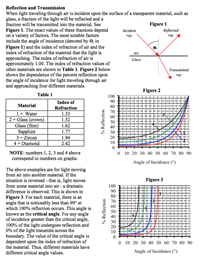 Reflection and Transmission
Reflection and Transmission
Resource:
The Science Reasoning Center: Reflection and Transmission
Grade Level: High School
Description:
This passage describes the variables that affect the percentage of incident light that undergoes reflection and transmission at the boundary between two materials. The passage uses a diagram, a table and two graphs to describe the relationships among variables. Questions target a student's ability to identify the effect of one variable on another variable, to select information from two or more data presentations, to make a prediction based on two or more data presentations, to interpolate and extrapolate from a graph, to compare data chosen from two or more graphs, and to use known data to make a prediction regarding an untested scenario.
Performance Expectation:
HS-PS4-3 Evaluate the claims, evidence, and reasoning behind the idea that electromagnetic radiation can be described either by a wave model or a particle model, and that for some situations one model is more useful than the other.
This activity aligns with the three dimensions of the Next Generation Science Standards in the manner described below:
| Electromagnetic Radiation (HS-PS4.B.1): Electromagnetic radiation (e.g., radio, microwaves, light) can be modeled as a wave of changing electric & magnetic fields or as particles called photons. The wave model is useful for explaining many features of electromagnetic radiation, and the particle model explains other features. |
While not explicitly stated in this passage, students may view the experiments discussed in this text as evidence supporting the wave model of light. It seems entirely plausible that energy from a wave could be ‘divided’ into that which is transmitted into a substance and that which is reflected from a substance. It seems more problematic, however, that a particle model of light can be used to explain this same phenomenon. After all, how could one particle ‘know’ to be transmitted while the next one ‘knows’ to be reflected? The results of this experiment have been used through history to support the wave model of light. |
| Scale, Proportion, and Quantity: The significance of a phenomenon is dependent on the scale, proportion, and quantity at which it occurs. |
This passage helps students understand how the amount of light reflected from an optically transparent material is dependent (among other things) on the angle of incidence. In other words, the percentage of light reflected grows from a small percentage (0 to 20% depending on the medium) to 100% as the angle of incidence approaches 90 degrees. Such a passage is a clear example of how this cross-cutting concept can be addressed within the study of physics with similar relationships found throughout the field of science. |
| Cause and Effect: Cause and effect relationships can be suggested and predicted for complex natural and human designed systems by examining what is known about smaller scale mechanisms within the system. |
Students may wonder why some light is transmitted and why some light is reflected when it approaches an interface between two optically transparent media. Furthermore, student may wonder why larger angles of incidence and larger indices of refraction cause a greater percentage of light to be reflected. While not simple, students may infer that the causes of such phenomena must be found by examining what is known about small scale mechanisms with the substances themselves. |
| Analyzing and Interpreting Data: Analyze data using tools, technologies, and/or models (e.g., computational, mathematical) in order to make valid and reliable scientific claims or determine an optimal design solution. |
Most of the questions at the end of this passage require students to use a diagram, a table, and two graphs to interpret relationships among several variables. These questions target a student's ability to identify the effect of one variable on another variable, to select information from two or more data presentations, to make a prediction based on two or more data presentations, to interpolate and extrapolate from a graph, to compare data chosen from two or more graphs, and to use known data to make a prediction regarding an untested scenario. |
| Engaging in Argument from Evidence: Make and defend a claim based on evidence about the natural world that reflects scientific knowledge, and student-generated evidence. |
Thinking like a scientist involves students being able to make and defend claims based on both evidence collected by students themselves as well as from their understand of the broader body of scientific knowledge. This passage provides students the opportunity to consider both experimental data as well as established scientific concepts as they make and defend various claims found in the end-of-passage questions. |
Associated Reading from The Physics Classroom
Other Supporting Pages at The Physics Classroom:
View Infographic.
(Coming Soon)
Search the NGSS Corner
Maybe you're looking for something really specific that pertains to a desired topic and emphasizes one or more of the listed NGSS dimensions. Why not try a search of this section of our website? Simply select from one or more of the pull-down menus and click Search This page will reload and a collection of possibilities will be displayed in this section of the page and sorted by relevancy.